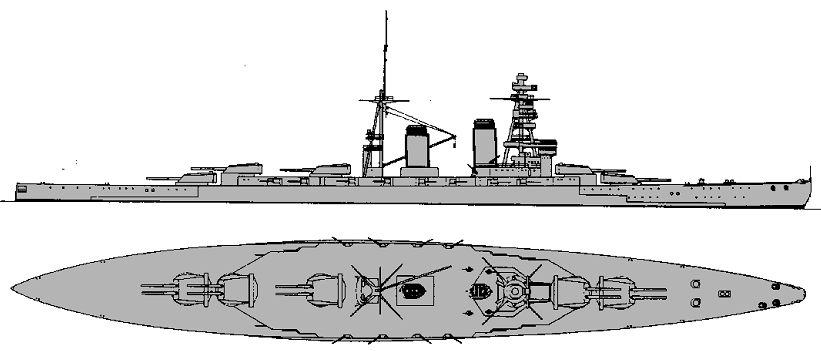
NAVYPEDIA
 Support the project with paypal
Support the project with paypal
Ships
| Name | No | Yard No | Builder | Laid down | Launched | Comp | Fate |
|---|---|---|---|---|---|---|---|
| 天城 [Amagi] | Yokosuka K K | 16.12.1920 | --- | --- | destroyed incomplete 1.9.1923 | ||
| 赤城 [Akagi] | Kure K K | 6.12.1920 | 22.4.1925 | 1927 // --- | competed as carrier 1927 | ||
| 愛宕 [Atago] | Kawasaki, Kobe | 22.11.1921 | --- | --- | incomplete, BU 1924 | ||
| 高雄 [Takao] (ex-愛鷹 [Ashitaka]) | Mitsubishi, Nagasaki | 19.12.1921 | --- | --- | incomplete, BU 1924 |
Technical data
| Displacement normal, t | 41217 |
|---|---|
| Displacement full, t | 47000 |
| Length, m | 274.1 wl 279.0 oa |
| Breadth, m | 30.8 |
| Draught, m | 9.50 |
| No of shafts | 4 |
| Machinery | 4 sets Gihon geared steam turbines, 19 Kampon boilers |
| Power, h. p. | 131200 |
| Max speed, kts | 30 |
| Fuel, t | coal 2500 + oil 3900 |
| Endurance, nm(kts) | 8000(14) |
| Armour, mm | belt: 254 + 30, bulkheads: 280 - 230, deck: 140 - 102, barbettes: 280, turrets: 280 - 230, casemates: 152, CT: 356 |
| Armament | 5 x 2 - 410/45 3-shiki, 16 x 1 - 140/50 3-shiki, 4 x 1 - 120/45 10-shiki, 8 - 610 TT (beam) |
| Complement |
Standard scale images

Amagi
Project history
This design B-64 of 1919, by Y Hiraga, was an enlarged Kaga with thinner belt and deck. Although 410mm/45 was planned, they might have been armed with a 410mm/50 tested in 1920. The secondary battery was reduced to 16 guns; note the use of a new AA gun. Hiraga considered turbo-electric drive (105,000shp = 28kts, 9600nm at 14kts). All construction as battlecruisers ceased on 5 February 1922 under the Washington Treaty when Amagi was 40% complete. It was originally planned to complete Amagi in November and Akagi in December 1923, and Atago and Takao in 1924.
Both Akagi and Amagi were to have been completed as aircraft carriers, corresponding to USS Lexington and Saratoga, but the latter was destroyed in the Tokyo earthquake and the fast battleship Kaga substituted. Conversion work had already begun, but the hull structure was too badly strained to be usable. She was stricken 31 July 1922 and BU began on 14 April 1924. Atago and Takao were cancelled 31 July 1922, stricken 14 April 1924 and BU on the slip. All named after mountains except Takao, a town.
Ship protection
15°inclined main belt had 254mm thickness between barbettes, tapering to 76mm at lower edge. Upper part of anti-torpedo longitudinal bulkhead extended up to main deck and served as 30mm splinter bulkhead. Main belt was closed by 280-229mm fore and 229mm aft bulkheads abreast end barbettes. Hull outside end barbettes was protected by 203mm belt tapered to 76mm at lower edge. Upper 229mm belt extended from main belt to upper deck between end barbettes. It was closed by 229mm angled bulkheads. Casemate had 152mm armor. Flat main 140-102mm deck connected with upper edge of main belt. Lower (splinter) deck had 38mm thickness in flat part and connected with lower edge of main belt by 76-51mm slopes. Deck over casemate was 38-25mm. Turrets had 356mm faces, 203mm sides and rears and 190mm crowns. CT had 356mm sides and 76mm roof. Underwater protection was 6.5m deep and content 76mm longitudinal bulkhead.
 HOME
HOME FIGHTING SHIPS OF THE WORLD
FIGHTING SHIPS OF THE WORLD JAPAN
JAPAN CAPITAL SHIPS
CAPITAL SHIPS AMAGI battlecruisers
AMAGI battlecruisers
